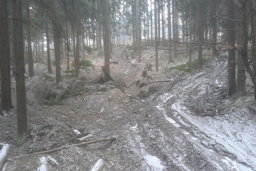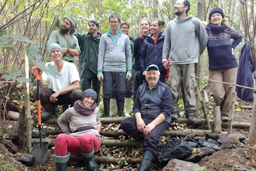Upper catchment of Vah River rehydratiation
Organization: PaW (Slovakia)
The Demonstrative Pilot Project for the Revival of Springs in the Váh River Basin aims to improve the abundance, stability, and robustness of the springs, hydrate the forest, and reduce soil erosion by slowing down the runoff of precipitation with the use of close-to-the-nature water retention measures. We want to prove that the right rainwater management with using rainwater retention measures can be used to regenerate springs and mitigate climate change.
The impact will be monitored and effectiveness quantified to allow replication in other areas. The expected long-term benefits are both the increased resistance of the micro-region to droughts and also the reduced risk of flash floods. Experience from over 30 years of PAW interventions will be utilized.










General Overview
The hydrology of the Danube River, particularly in the Slovakian part of the basin, is affected by the management of rainwater in the landscape. Human economic activities in rural areas have been underestimated, leading to a decrease in water resources in headwater areas. This has caused springs and small watercourses in Slovakia to dry up, impacting river flows during long-term droughts.
The DALIA research project in Slovakia aims to demonstrate that simple and inexpensive measures can restore underground water sources and spring yield, contributing to strategic planning and integrated watershed management.
The Slovakian part of the Danube basin covers 46,961 km² and is characterized by spring water resources, influenced by various land uses such as forestry, agriculture, and urbanization. Over 65,000 km of small watercourses in Slovakian headwaters contribute to the Danube's tributaries. The Váh and Hron rivers are the only two rivers in Slovakia flowing directly into the Danube, with the rest influencing Hungarian lowland rivers before reaching the Danube.
The region receives about 34.3 billion m³ of precipitation annually, with approximately 12 billion m³ flowing through river networks to the Danube. The hydrogeological conditions in the Paleogene flysch sediments present challenges for significant groundwater accumulation and circulation. The lithological nature of the flysch zone limits favorable conditions for groundwater circulation, and the influence of geological structure is suppressed by geomorphological conditions.
The Kysúc region in the Slovakian basin has a distinct climatic profile, belonging to the moderately cold climatic zone (C1), with cold winters and a basin climate. The area has a forest cover of 51%, and economic use has impacted the hydrological regime, particularly due to flood disasters. The northwestern part of the Kysúce Basin is a Protected Landscape Area with various small protected areas.
Implemented measures
The Slovakian Danube Protection Strategy (DPS) emphasizes the rejuvenation of degraded landscapes through Nature-Based Solutions (NBS), focusing on restoring springs, and small watercourses, and safeguarding communities from floods. The initiative aims to address critical questions, such as optimizing water extraction from rainwater while mitigating flood risks, testing methods for calculating rainwater runoff volume and understanding the impact of NBS on spring yields and small watercourse hydrology. Additionally, it aims to describe NBS technologies and develop tools for obtaining water resources through ecosystem restoration.
The chosen model area is the headwaters of the Kysuca River, part of the Váh River tributary, covering 1053 km². The project, as part of the Slovakian DPS, seeks to gain knowledge on the impact of landscape revitalization on water restoration and develop systematic measures for basin-wide restoration. By establishing a monitoring network, the project aims to provide information for methodically restoring water to damaged landscapes, addressing hydrological processes, and flood conditions, and enhancing river hydrology.
The methodology involves installing hydro-meteorological stations in ten selected micro-catchments to measure precipitation parameters, assess responses to events, and evaluate the effects of water retention measures. Half of the micro-catchments will undergo modifications, while the rest will serve as a control group. The project aims to achieve proper freshwater management by slowing runoff, reducing soil erosion, rehydrating the environment, increasing water tables, and implementing flood prevention measures.
Lastly, in response to the 2004 windstorm in the High Tatras National Park, the project 'WATER FOREST OF SLOVAK SAVIN BANK – ecosystem restoration of damaged forest in High Tatra National Park after the windstorm in 2004' was initiated. This project focused on repurposing fallen wood for water retention measures, demonstrating an innovative approach to ecosystem restoration. It involved extensive volunteer efforts, global collaboration, financial support from “Slovenská sporiteľňa”, and coordination by the NGO People and Water.
Impact of the measures on the environment
Assuming that retained rainwater saturates the soil, supporting ecosystems and promoting vegetation growth, the benefits extend to climate moderation and increased biodiversity in landscapes. Utilizing stormwater runoff for new water sources is crucial for informed community decisions. Ecosystem-based water resource protection, exemplified in New York's Running Pure study, proves more cost-efficient than dam construction Government action in response to floods leads to landscape revitalization and flood management programs in Slovakia. Over 100,000 water retention measures are implemented, driven by a strategy to maintain low costs and generate job opportunities. The approach involves creating entire cascades of water retention measures in mountain forest areas, with a focus on areas with genuine needs and low budgetary costs.
Summary and recommendations
The experimental validation of rainwater retention and runoff slowing for restoring groundwater, replenishing springs, and mitigating soil erosion and flash flood risks is pursued, with hypotheses postulating positive effects on micro catchment behavior, spring stability, spring yield, and surface runoff mitigation. Material and labor costs are meticulously tracked for future cost-benefit planning.
The innovative project focuses on the restoration of wind-damaged monocultural forests through rainwater retention and diversified forest planting, as demonstrated in successful projects in the Tatra Mountains.
Rainwater runoff analysis within the administrative unit of the Kysuce basin, covering 87% of the area (1053 km²), reveals surprising contributions to flood occurrences from urbanized areas. Calculated volumes of rainwater runoff and ongoing monitoring projects aim to establish correlations between water retention and increased water yield. Approximately 5.8 million cubic meters of rainwater flow into the river system during extreme precipitation events. The goal is to correlate water retention measures with an augmented water resource yield. Also, the continuous refinement of methodology and collaboration with experts and local communities are deemed essential for enhancing the impact of the study.
